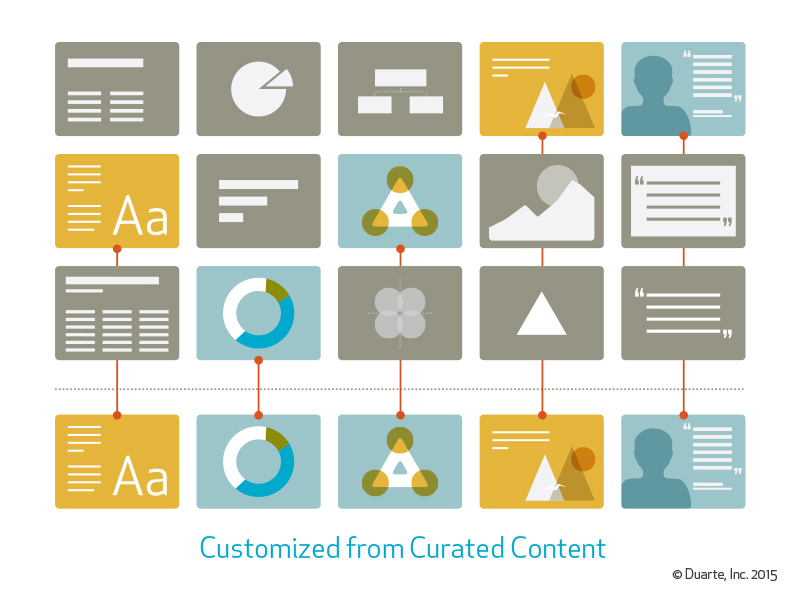
This article by Nancy Duarte is part of our Blogtober event, which features blog posts written by industry influencers in support of Breast Cancer Awareness Month.
Creating a good sales presentation is akin to landing a helicopter on a moving train. Think I’m kidding? Think about it. It’s hard enough creating one presentation for one presenter to give to one audience. Creating a presentation for an entire sales force to use for many different prospects across many different industries, products, or services is a challenge that requires a high level of skill, fluidity, and coordination.
For maximum impact, each presentation delivered needs to be tailored to a specific audience. However, when marketers create master sales presentations to arm a sales force of even 10 people (though the number can reach into the hundreds), it’s nearly impossible to create something that will adapt to every sales situation, every speaking style, and the many different ways to tell a story.
This is one reason salespeople spend so much time and energy tearing the “master sales presentations” apart and piecing them back together. And in a way, this is exactly what they should do in order to customize their presentation to the variety of factors mentioned earlier. The challenge lies in making this process as easy as possible for the sales team so that the core presentation applies to as many audience members as possible without being too vague. Ideally, the core presentation should also take relatively little time to customize, help the team stay on brand message, and leave the presenter with enough flexibility to fit their individual style and skill level.
There is no current presentation tool where you insert your parameters (one sales presentation for X product given to X type of prospect at X stage of the sales cycle and given by a presenter at X skill level). Yet, there are ways to provide salespeople with enough options and flexibility that presenters can stay on message and customize presentations to their needs.
Modular presentations

The most straightforward way to do this is through a modular sales presentation. These presentations include a relatively baked story structure that sets the salesperson up with a common brand story. Within these presentations there are usually several areas where the presenter can substitute a variety of modules to fit their particular need.
For instance, the base presentation may capture the basic story and the problem it addresses, but there may be different slides or a set of slides that can be switched out to feature various products, customer examples, case studies, etc.
Modular presentations work best if your core story is the same for every audience. If your salespeople are telling the same basic story to a variety of audiences with the same basic needs, then a modular presentation is the way to go. However, the more complicated the range of audiences, use cases, and products the more unwieldy the presentation becomes.
Inexperienced presentation creators try to solve this problem by generalizing the message so that it can fit every audience. But often times the output from these attempts is so vague that they don’t fit any audiences, and are left unused by the sales team.
Slide libraries

A more flexible and adaptive approach to arming your sales team with the tools necessary to present your story is to create a slide library. Slide libraries, as the name suggests, are a large set of slides that people can pick and choose from to create their presentations.
These types of slide repositories are created by brainstorming every type of slide a salesperson might need, then creating and providing them in a repository.
This type of resource allows for maximum flexibility. If sales wants to, they can create a presentation from scratch every time without going through the time-honored tradition of hacking together multiple decks. It will also ensure that the slides fit together as a system, since combining multiple decks often results in a group of slides with styles or messages that don’t quite fit together.
However, with flexibility also comes the ability to deviate from the standard brand messages. Inexperienced sales teams may struggle with this option and often need additional guidance from an approved story structure or a set of content-generation guidelines.
Adaptive presentations

A third kind of sales presentation is an adaptive sales presentation. This is an adaptive toolkit that helps the salesperson facilitate a conversation. This carefully curated set of visuals allows salespeople to deliver a non-linear presentation at the pace of the conversation.
Adaptive presentations are free-flowing conversations that are agile enough to respond to the prospects needs and interests. However, these types of presentations also require the most planning up front because you have to be able to imagine the flow of a conversation and prepare the presentation structure and message to easily flow from one subject to the next.
When it comes down to it, though, the best salesperson can sell their product or service without any support, while the best sales presentation in the world can’t help less skilled presenters. The important thing to remember is to assess the skills and flexibility of your message and choose the option that’s best for your circumstances.
Nancy Duarte is the author of the all-new edition of the HBR Guide to Persuasive Presentations, as well as two award-winning books on the art of presenting, Slide:ology and Resonate. Her team at Duarte, Inc., has created more than a quarter of a million presentations for its clients and teaches public and corporate workshops on presenting. Follow Duarte on Twitter: @nancyduarte.
Like what you read? Please consider donating to the Canadian Breast Cancer Foundation and sharing this article. http://www.cbcf.org/ontario/GetInvolved/Donate/Pages/default.aspx

























